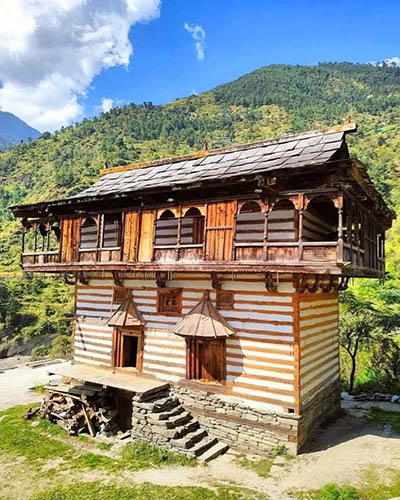In the heart of the Himalayan region, where winter's icy grip and bone-chilling snowfalls are a way of life, the kaath-kuni houses stand as stoic witnesses to a fading era of hill architecture.
Once hailed as the tour de force of craftsmanship, these structures were designed to endure seismic tremors with unwavering resilience that merge symbiotically with the green hills of the Himalaya.
Picture a kaath-kuni house, a testament to the artistry of the hills.
Rising proudly, it could boast anywhere from five stories to three, each level revealing a purpose intricately woven into the fabric of daily life.
At the pinnacle, beneath the protective slate roof, lies the 'Darek'—a sanctuary for wood and utensils.
Just below, the 'rasoi' exudes warmth, serving as both a kitchen and a sleeping space.
Descending to the 'paand,' the major sleeping area, one finds a simplicity that defines the essence of hill living.
With no doors to separate, only a small stair connects it to the 'rasoi or kitchen. Further down is the 'obri,' a refuge for sheep and goats accessible through an outer stair.
At the very base, the 'obra' houses the cherished cattle cows, calfs and bulls.
The term "kaath-kuni" whispers through the hills, signifying a construction meticulously crafted from local wood mainly pines.
The corners, a dense of cross-fitting of timber panels, provide a robust, interlocking strength.
Long wood logs, standing parallel on both outer and inner sides, unite the four walls with a sturdy embrace.
Gaps, filled with a mixture of clay, red soil, Gober, and chir needles known as 'gara,' create a protective shield, which keeps inner areas warm and cozy in winter.
The final touch, a coat of white distemper named 'Makol,' sourced from the marshy lands of hills, bestows an aesthetic charm and is considered pure and eco-friendly.
Comprising manganese oxide, silicate, and locally available wood painted with 'Gara', it transforms the house into a piece of art.
Amidst the chill of winter, life within these kaath-kuni houses in the hills of Himachal is nothing short of cozy.
The pahari cows and cattle have gone. So is the case with sheep and goats.
As modernization sweeps through and timber becomes scarce, these architectural marvels are gradually giving way to structures of bricks and mortar, leaving behind a fading legacy of a bygone era.
The kaath-Kuni houses now survive in Inner and outer Seraj and Kullu, Mandi, parts of Mahasu and few others places.




